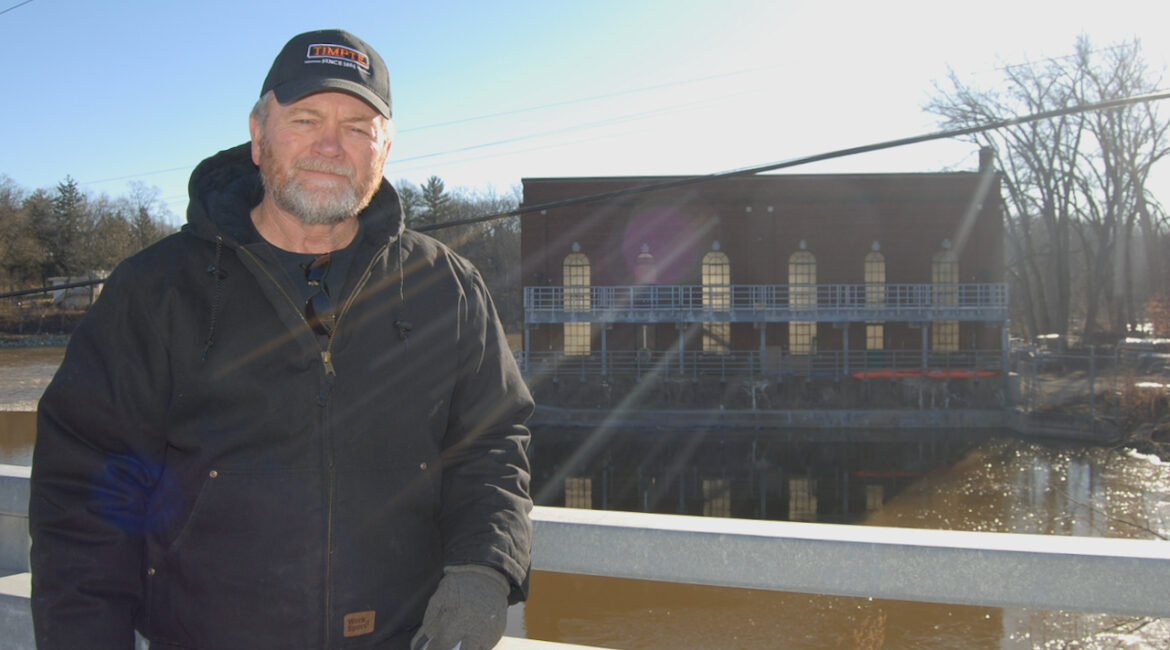By Kim McDarison
Those traveling through the sleepy community of Indianford may have noticed that one of the area’s iconic buildings is sporting a new look.
The upriver or north side of the powerhouse, which is a component of the Indianford dam, has been outfitted with a two-story I-beam and walkway structure which will soon support six slide gates.
The full dam includes the powerhouse, situated on the west side of the Rock River, a spillway spanning the river and six slide gates situated on the east side of the river.
The Indianford dam impounds Lake Koshkonong, a more than 10,000-acre waterbody located in Jefferson, Rock and Dane counties.
According to De Pere-based construction firm IEI crew foreman Bill Stewart, as of Thursday, exterior work on the structure is “mostly” complete. The new slide gates are on site and are anticipated, borrowing any further delays brought by high water at the dam, to be installed in January, 2023.
The full project, which includes interior work at the powerhouse both at grade level and underneath the building, is about 45% completed and is anticipated to finish in March, 2023, he said.
Stewart said that while cold weather affects some aspects of the work, it’s high water levels that really slow the project down.
Work was initially slated to begin in March, 2022, but actually began closer to mid-June, he said, adding: “We started here for five or six weeks, and then we stopped for three weeks because of high water. We started back up again in mid-September.
Along with the six new slide gates waiting to be installed, electronic controllers for each gate also have arrived, he said.
Rock-Koshkonong Lake District (RKLD) Board of Commissioners Chairman Alan Sweeney said Thursday that a rebar structure had recently been put in place to reinforce concrete, some of which was poured Wednesday, to create a “spillway” underneath the powerhouse. Plans call for two such spillways to be created. The bowl-shaped structures will receive water once it passes through the new slide gates. Water will next exit from of the building on the downstream or south side in much the same way as it has in the past.
Describing structural changes underway below surface, Sweeney said former structures, including two wicket gate carousels and the concrete curbs which held them in place, have been removed.
Before construction of the new system began, two cavities, each housing a wicket gate carousel, were situated underneath the powerhouse floor. Water passed through a grated trash rack system situated on the building’s upriver side and into the cavities where it engaged with the carousels. A series of levers, designed to pivot with water flow, were attached to each carousel. A concrete curb system kept the carousals in position and allowed them to turn as the water passed through. The system was designed to power generators which were once situated above grade in the powerhouse to produce electricity.
The generators and any other equipment used to create power was long-ago removed from the building, Sweeney has noted in past interviews. The wicket gate carousels, although not ideal for regulating water levels, had remained in use.
With the new system, trash racks are replaced with a floating boom, which will be configured in the water upriver from the powerhouse. Its purpose will be to move large debris away from the six powerhouse slide gate, while still allowing river water to pass through. Once inside the building, the water will pass through the two bowl-shaped spillways and exit the building.
Once the full project is completed, the powerhouse will have two bays, each with three slide gates, and a below surface spillway. The rest of the space below the powerhouse floor will be filled with concrete, Sweeney said, adding that he estimated more than 80 yards of concrete were poured to create the new spillways on Wednesday.
The crew looks for best conditions when pouring the concrete, he said, noting that an internal ambient temperature in the building must be around 40 degrees so the concrete can properly cure. Heaters have been brought into the building to facilitate the process, he said.
Looking at the new structure outside of the powerhouse, I-beams have been installed to create a framework within which the six new slide gates will be mounted.
When the work is complete, Sweeney said, the structure will be painted green to match the trim on the historical powerhouse building.
As part of the project’s approval process, the powerhouse, which was built in 1928, was evaluated by the Wisconsin Historical Society and placed on the society’s Agriculture and History Inventory.
When the full project is completed, the inside of the powerhouse will present with a flat floor and empty space. A new stairway is in place inside the building to allow an operator access to the electronic equipment that will control the slide gates.
Plans indicate that each slide gate will have its own set of controls.
According to Sweeney, once the project is completed, RKLD dam and powerhouse principal operator Kim Bothom will no longer need to clean trash racks, however, his job will continue to include making daily reports to the Wisconsin Department of Natural Resources (DNR) about water levels on Lake Koshkonong, which are controlled by the dam, and providing daily inspections of the equipment and the gates to be sure they remain free from debris.
Sweeney said the new system will better allow the lake district to maintain water levels on Lake Koshkonong and control the flow of water, which will also allow it to stay in compliance with its operating order from the DNR.
The district is receiving United States Geological Survey (USGS) water flow rate information coming from a buoy which shares information with the district through the internet, he said.
According to USGS data, the buoy is located near Bingham Point Estates.
Using USGS-supplied data, Sweeney said, patterns in changing water levels on Lake Koshkonong can become “somewhat predictable,” giving the district’s operator an ability to anticipate water levels on the lake and at the dam.
“We can anticipate water levels instead of reacting to them,” Sweeney said.
While the predictive formula is still under development, he said, he anticipated that it will be able to take into consideration water inputs from the 11 sewage treatment plants operating in the watershed and rainfall runoff.
Looking ahead
With new gates in place and an improved ability to control water, Sweeney said RKLD commissioners have been discussing at their monthly board meetings a desire to return to what has been an ongoing discussion about Lake Koshkonong water levels.
In 2017, RKLD and the DNR arrived at an agreement allowing a two-step increase to the summer water level on Lake Koshkonong of 5 inches. The lake’s summer water level was raised by 2.5 inches in 2017. A second 2.5-inch increase, scheduled to take place in 2019, did not occur. The agreement stipulated that the second increase would be granted only after the DNR completed an assessment of any impacts to wetlands brought about by the additional water allowed in 2017. The study was delayed due to high water levels above the DNR operating order.
“The new gates will allow us the ability to control water and it would be appropriate for the discussion about water level increases to take place,” Sweeney said, adding that the RKLD board also would like to hear thoughts from the lake district’s residents about water level increases. He said he believed different types of users of the asset might have differing ideas about water levels and future increases.
“We want to have a public listening session to see what people would like,” he said, adding: “With the new gates, we will be able to regulate water better than we have in the past, and that should be part of that discussion.”
Additionally, Sweeney said RKLD board members also have been learning about water quality and best practices to help keep runoff, especially from farm fields that might carry fertilizer and phosphorus loads into the lake.
“The idea is to create barriers so farmers are not farming right up to the lake,” Sweeney, who is a farmer, said.
About the lake district and DNR water level agreement
In 2017, the lake district and the DNR, after more than a decade of litigation, arrived at an agreement in which summer water levels on Lake Koshkonong would be allowed to increase.
The agreement stipulated that the DNR would initiate a two-step process, the first of which would take place in July of 2017, allowing an increase of 2.5 inches to summer water levels on the lake. If, after monitoring the effects of the first increase, no adverse impacts were determined to have taken place to surrounding wetlands as a result of the increase, a second increase of 2.5 inches would be implemented in the summer of 2019.
While the first step in the process did take place, the second step did not. DNR officials have cited in the years between 2019 and 2020, flooding in the area, likely due to increased rainfall and runoff, which prevented the department from being able to conduct proper studies of the impacts of wetlands brought about by the first step in the process.
In 2020, the district learned that the DNR had placed a stay on the dam’s operating order, effectively postponing a final decision about initiating the second approximately 2.5-inch water increase that had been slated to take place in 2019. The department, at that time, according to Sweeney, noted that severe impacts to wetlands had taken place, but the cause of the impacts were not yet determined.
An earlier story about the project is here: https://fortatkinsononline.com/wicket-gate-replacement-underway-at-indianford-dam/.
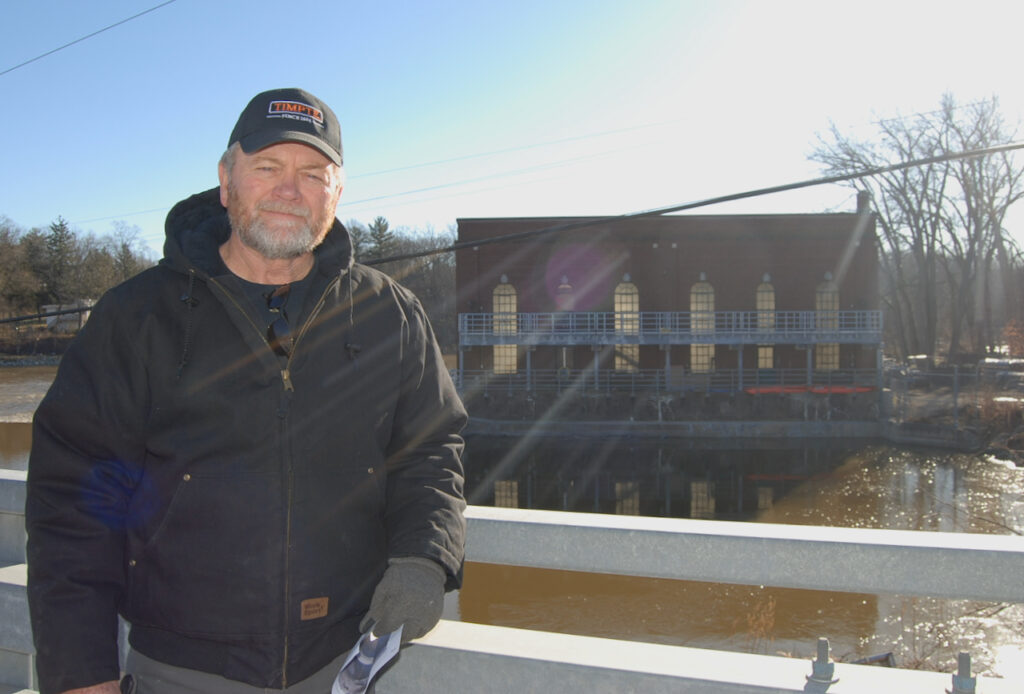
Rock-Koshkonong Lake District Board of Commissioners Chairman Alan Sweeney stands on the West County Road M bridge spanning the Rock River in Indianford. The Indianford dam powerhouse, and a structure under construction to house six new slide gates, loom in the background.
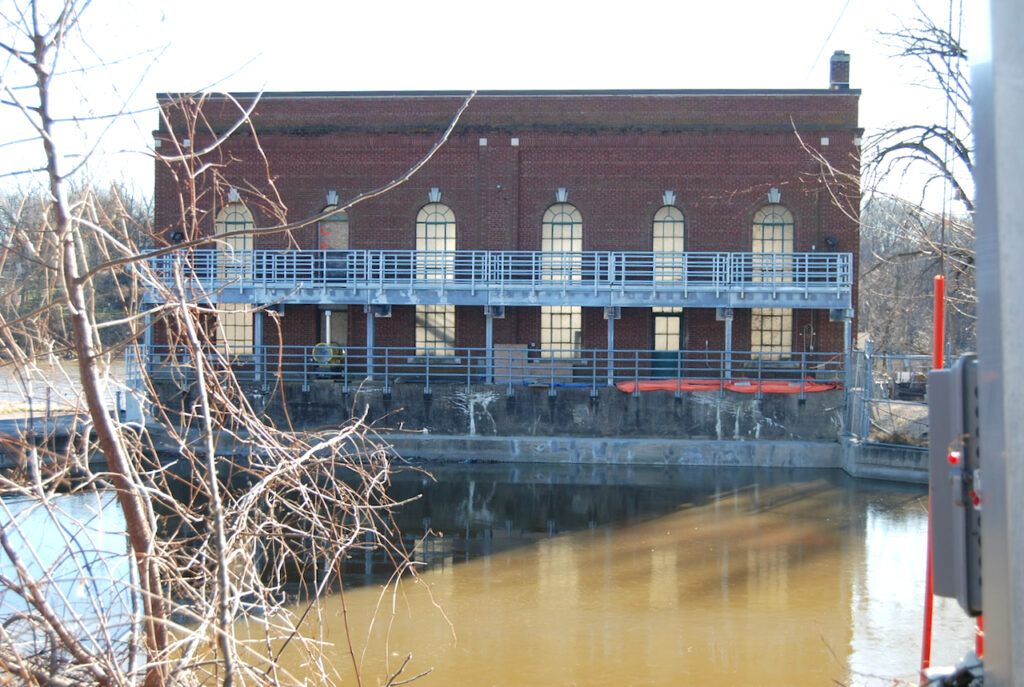
Build in 1928, the powerhouse is listed on the Wisconsin Historical Society’s Agriculture and History Inventory. The exterior framework that will soon hold six slide gates will be painted a period-appropriate green, according to lake district chairman Alan Sweeney.
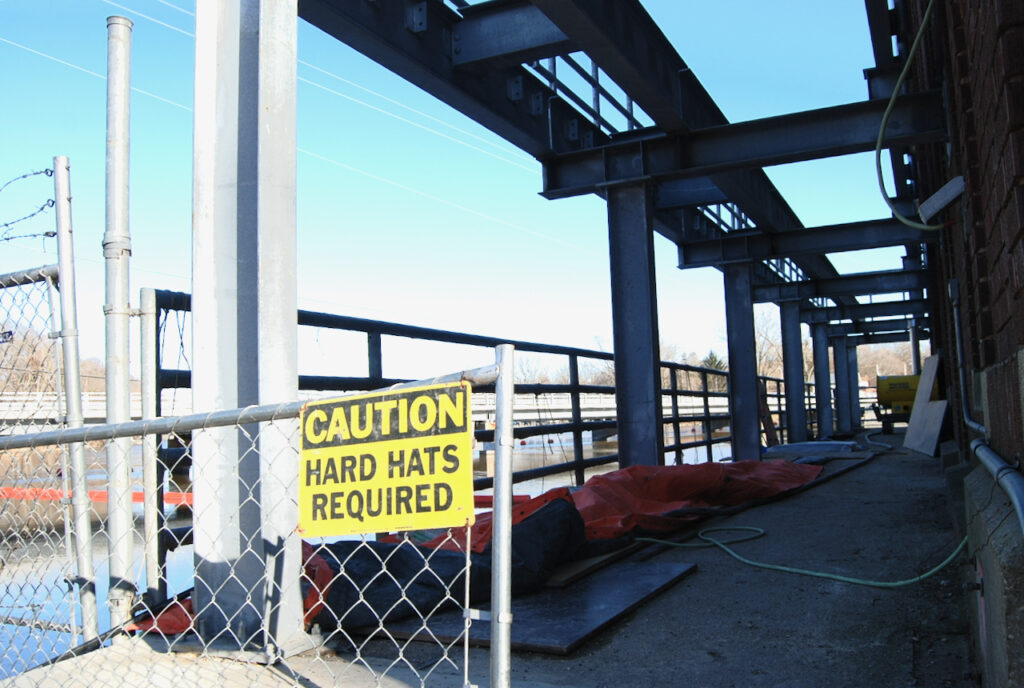
A structure developing on the powerhouse’s upriver or north side, will soon hold six slide gates, one in each of the partitioned sections separated by I-beams. Plans call for the full project, including alterations underway inside the building, to be completed by March of 2023.
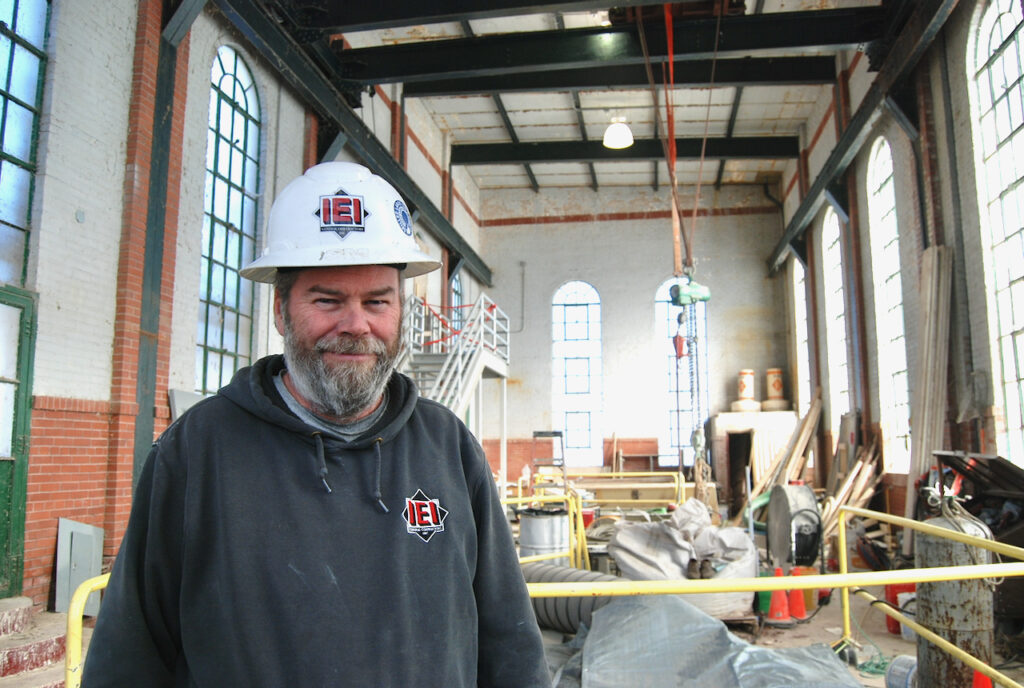
De Pere-based construction firm IEI crew foreman Bill Stewart Thursday directs work underway inside the Indianford dam powerhouse. Stewart said the full project is about 45% complete. The project, which includes an outside structure upon which six slide gates will be mounted, removal of below grade wicket gates, new below grade spillways, and an inside stairway to allow access to slide gate controls, is expected to complete in March, 2023. The project comes at a cost of approximately $2.275 million.
Kim McDarison photos.
This post has already been read 2271 times!
